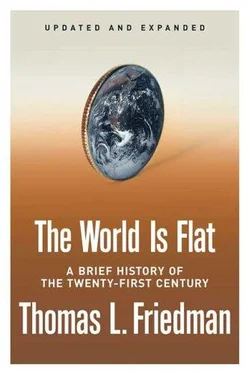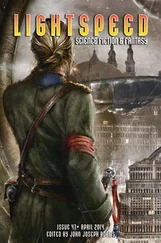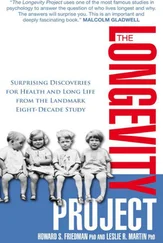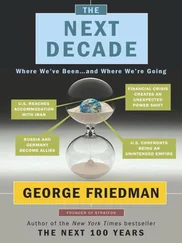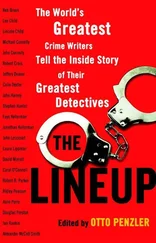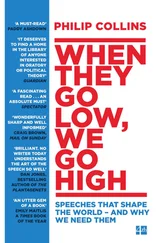In the flat world it is much more difficult to hide, but much easier to get connected. “Think of Mao at the beginning of the Chinese communist revolution,” remarked Michael Mandelbaum, the Johns Hopkins foreign policy specialist. “The Chinese Communists had to hide in caves in northwest China, but they could move around in whatever territory they were able to control. Bin Laden, by contrast, can't show his face, but he can reach every household in the world, thanks to the Internet.” Bin Laden cannot capture any territory but he can capture the imagination of millions of people. And he has, broadcasting right into American living rooms on the eve of the 2004 presidential election.
Hell hath no fury like a terrorist with a satellite dish and an interactive Web site.
Too Personally Insecure
In the fall of 2004,1 was invited to speak at a synagogue in Woodstock, New York, home of the famous Woodstock music festival. I asked my hosts how was it that they were able to get a synagogue in Woodstock, of all places, big enough to support a lecture series. Very simple, they said. Since 9/11, Jews, and others, have been moving from New York City to places like Woodstock, to get away from what they fear will be the next ground zero. Right now this trend is a trickle, but it would become a torrent if a nuclear device were detonated in any European or American city.
Since this threat is the mother of all unflatteners, this book would not be complete without a discussion of it. We can live with a lot. We lived through 9/11. But we cannot live with nuclear terrorism. That would un-flatten the world permanently.
The only reason that Osama bin Laden did not use a nuclear device on 9/11 was not that he did not have the intention but that he did not have the capability. And since the Dell Theory offers no hope of restraining the suicide supply chains, the only strategy we have is to limit their worst capabilities. That means a much more serious global effort to stanch nuclear proliferation by limiting the supply-to buy up the fissile material that is already out there, particularly in the former Soviet Union, and prevent more states from going nuclear. Harvard University international affairs expert Graham Allison, in his book Nuclear Terrorism: The Ultimate Preventable Catastrophe, outlines just such a strategy for denying terrorists access to nuclear weapons and nuclear materials. It can be done, he insists. It is a challenge to our will and convictions, but not to our capabilities. Allison proposes a new American-led international security order to deal with this problem based on what he calls “a doctrine of the Three No's: No loose nukes, No new nascent nukes, and No new nuclear states.” No loose nukes, says Allison, means locking down all nuclear weapons and all nuclear material from which bombs could be made-in a much more serious way than we have done up till now. “We don't lose gold from Fort Knox,” says Allison. “Russia doesn't lose treasures from the Kremlin armory. So we both know how to prevent theft of those things that are super valuable to us if we are determined to do it.” No new nascent nukes means recognizing that there is a group of actors out there who can and do produce highly enriched uranium or plutonium, which is nothing more than nuclear bombs just about to hatch. We need a much more credible, multilateral nonprolif-eration regime that soaks up this fissile material. Finally, no new nuclear states means “drawing a line under the current eight nuclear powers and determining that, however unfair and unreasonable it may be, that club will have no more members than those eight,” says Allison, adding that these three steps might then buy us time to develop a more formal, sustainable, internationally approved regime.
It would be nice also to be able to deny the Internet to al-Qaeda and its ilk, but that, alas, is impossible-without undermining ourselves. That is why limiting their capabilities is necessary but not sufficient. We also have to find a way to get at their worst intentions. If we are not going to shut down the Internet and all the other creative and collaborative tools that have flattened the world, and if we can't restrict access to them, the only thing we can do is try to influence the imagination and intentions that people bring to them and draw from them. When I raised this issue, and the broad themes of this book, with my religious teacher, Rabbi Tzvi Marx from Holland, he surprised me by saying that the flat world I was describing reminded him of the story of the Tower of Babel.
How so? I asked. “The reason God banished all the people from the Tower of Babel and made them all speak different languages was not because he did not want them to collaborate per se,” answered Rabbi Marx. “It was because he was enraged at what they were collaborating on-an effort to build a tower to the heavens so they could become God.” This was a distortion of the human capacity, so God broke their union and their ability to communicate with one another. Now, all these years later, humankind has again created a new platform for more people from more places to communicate and collaborate with less friction and more ease than ever: the Internet. Would God see the Internet as heresy?
“Absolutely not,” said Marx. “The heresy is not that mankind works together-it is to what ends. It is essential that we use this new ability to communicate and collaborate for the right ends-for constructive human aims and not megalomaniacal ends. Building a tower was megalo-maniacal. Bin Laden's insistence that he has the truth and can flatten anyone else's tower who doesn't heed him is megalomaniacal. Collaborating so mankind can achieve its full potential is God's hope.”
How we promote more of that kind of collaboration is what the final chapter is all about.
THIRTEEN: 11/9 Versus 9/11
Imagination is more important than knowledge.
—Albert Einstein
On the Internet, nobody knows you're a dog.
—Two dogs talking to each other, in a New Yorker cartoon by Peter Steiner, July 5, 1993
Reflecting on this past decade and a half, during which the world went flat, it strikes me that our lives have been powerfully shaped by two dates: 11/9 and 9/11. These two dates represent the two competing forms of imagination at work in the world today: the creative imagination of 11/9 and the destructive imagination of 9/11. One brought down a wall and opened the windows of the world-both the operating system and the kind we look through. It unlocked half the planet and made the citizens there our potential partners and competitors. Another brought down the World Trade Center, closing its Windows on the World restaurant forever and putting up new invisible and concrete walls among people at a time when we thought 11
The dismantling of the Berlin Wall on 11/9 was brought about by people who dared to imagine a different, more open world-one where every human being would be free to realize his or her full potential—and who then summoned the courage to act on that imagination. Do you remember how it happened? It was so simple, really: In July 1989, hundreds of East Germans sought refuge at the West German embassy in Hungary. In September 1989, Hungary decided to remove its border restrictions with Austria. That meant that any East German who got into Hungary could pass through to Austria and the free world. Sure enough, more than thirteen thousand East Germans escaped through Hungary's back door. Pressure built up on the East German government. When in November it announced plans to ease travel restrictions, tens of thousands of East Germans converged on the Berlin Wall, where, on 11/9/89, border guards just opened the gates.
Someone there in Hungary, maybe it was the prime minister, maybe it was just a bureaucrat, must have said to himself or herself, “Imagine—imagine what might happen if we opened the border with Austria.” Imagine if the Soviet Union were frozen in place. Imagine-imagine if East German citizens, young and old, men and women, were so emboldened by seeing their neighbors flee to the West that one day they just swarmed that Berlin Wall and started to tear it down? Some people must have had a conversation just like that, and because they did, millions of Eastern Europeans were able to walk out from behind the Iron Curtain and engage with a flattening world. It was a great era in which to be an American. We were the only superpower, and the world was our oyster. There were no walls. Young Americans could think about traveling, for a semester or a summer, to more countries than any American generation before them. Indeed, they could travel as far as their imagination and wallets could take them. They could also look around at their classmates and see people from more different countries and cultures than any other class before them.
Читать дальше
